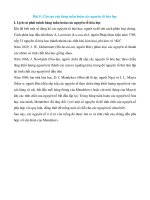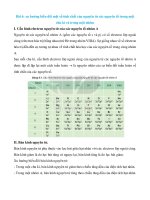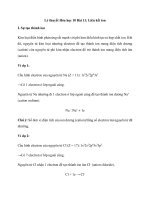BÀI KIỂM TRA TỰ LUẬN ĐẤT NƯỚC HỌC
Bạn đang xem bản rút gọn của tài liệu. Xem và tải ngay bản đầy đủ của tài liệu tại đây (1.77 MB, 19 trang )
CANADA
The flag of Canada
The Capital of Canada is OTTAWA
KHỔNG HỒNG AN
CANADA
I. OVERVIEW
- Area: 9.976.139 square kilometres
- Population: 34.482.779 square kilometres
- Language: English or French
- Goverment: Parliametary democracy
- Official Head Of State: Queen.
- Government General: David Lloyd Johnston
- PM: Stephen Harpher.
- The second largest country, after Russia
- The world’s leading industrial nations.
- Having the best standard of living in the world in terms of health care, education, clean-environment and
other the same things.
- Very small population and former colony of Great Britain
- Its policy of actively encouraging immigration.
KHỔNG HỒNG AN
II. The regions of Canada
Located on the North American Continent.
Bordered by The Pacific Ocean on the west coast and the Atlantic
Ocean on the east coast.
Shared land and border with the United States to the South and
Northwest.
Its physical geography includes mountains, rivers, oceans and
prairies and variety of different climates.
It consists of 10 provinces and 2 territories
KHỔNG HỒNG AN
III. Geography
By total area (including its waters), Canada is the Second largest
country in the world, after Russia. By land area alone, Canada ranks
fourth, due to having the world's largest area of fresh water lakes.
Canada also has vast maritime terrain, with the world's longest coastline of
243,042 kilometres (151,019 mi)
Canada can be divided into seven physiographic regions: the Canadian shield,
the interior plains, The Great lakes – St, Lawrence Lowlands, The Appalachian
region, Western Cordillera, Hudson Bay Lowlands and The Arctic Archipelago.
Canada has over 2,000,000 lakes—563 of which are larger than
100 km2 (39 sq mi)—containing much of the world’s fresh water.
KHỔNG HỒNG AN
IV. History
Aboriginal peoples – the native Indians with rich cultures and highly developed
societies inhabited in many regions of North American Prehistorically.
Europeans first arrived when the Vikings settled AD 1000.
Settlement by Europeans did not begin until the 17 th century.
French colonists first settled in Canada for fur trade.
The British – jealous of French success and began to compete for territory and
trading centers.
18th century : Indian tribes battle with The French and British entrepreneurs.
Wars between Britain and France in Europe affected the Fortunes of what
would one day become Canada , as overseas territories and rights were won,
lost and traded.
1867 Canada born when Quebec, Ontario, New Brunswick and Nova Scotia all
joined together. As time passed, other provinces and territories also joined.
KHỔNG HỒNG AN
V. The Canadian people
Immigration has been a key part in Canadian society’s growth
throughout our nation’s history.
Canada’s population of over 36 million people reflects a cultural,
ethnic and linguistic mix that is unique in the world.
Canadian multiculturalism is based on the belief that all citizens are
equal and that diversity makes us stronger as a country.
KHỔNG HỒNG AN
Founding peoples of Canada
include :
•
Aboriginal peoples:
•
French Canadians:
•
English Canadians:
There are three different groups
of Aboriginal peoples: First Nations, Inut and Me’tis
French Canadians are the
descendants of French settlers and include: Acadians, Quebecers
and people in smaller French- speaking communities across Canada.
Most English Canadians are
descendants of English, Welsh, Scottish and Irish people. These
include settlers, soldiers and migrants who came to Canada from
the 17th to the 20th century. Generations of these pioneers helped
bring British political customs and traditions to Canada.
KHỔNG HỒNG AN
VI. CULTURES
Canada's culture draws influences from its broad range of constituent nationalities, and
policies that promote a "just society" are constitutionally protected.
Canada has placed emphasis on equality and inclusiveness for all its people.
The official state policy of multiculturalism is often cited as one of Canada's significant
accomplishments and a key distinguishing element of Canadian identity.
As a whole, Canada is in theory a cultural mosaic of regional ethnic subcultures.
Canada's approach to governance emphasizing multiculturalism, which is based on
selective immigration, social integration, and suppression of far-right politics, has wide
public support.
Government policies such as publicly funded health care, higher taxation to
redistribute wealth, the outlawing of capital punishment, strong efforts to
eliminate poverty, strict gun control, a social liberal attitude toward women's rights
(like pregnancy termination) and LGBTQ rights, legalized euthanasia and cannabis use
are indicators of Canada's political and cultural values.
KHỔNG HỒNG AN
VII. Government and politics
1.
STRUCTURES OF GOVERMENTS
Canada is a constitutional Monarchy with Elizabeth II. Queen of
Canada, as Head of State.
Governor – General, on the recommendation on the Prime
Minster, represents the Queen.
Both the Queen and Government General occupy largely
ceremonial roles.
A Parliamentary democracy with federal system of
parliamentary government and strong democratic traditions.
The constitution is the supreme law of the country and consists
of written text and unwrite conventions.
KHỔNG HỒNG AN
VII. Government and politics
2. Parties.
The Liberal
The Progressive Conservative
The Bloc Quebecois
The Reform.
KHỔNG HỒNG AN
VIII. Economy
Canada has a highly developed mixed-market economy, with the world's
eighth-largest economy as of 2022, and a nominal GDP of approximately
US$2.221 trillion.
It is one of the least corrupt countries in the world, and is one of the world's
largest trading nations, with a highly globalized economy.
In 2021, Canadian trade in goods and services reached
$2.016 trillion. Canada's exports totalled over $637 billion, while its imported
goods were worth over $631 billion, of which approximately $391 billion
originated from the United States.
Canada is one of the few developed nations that are net exporters of energy.
KHỔNG HỒNG AN
IX. Climate
Average winter and summer high temperatures across Canada vary from
region to region.
Winters can be harsh in many parts of the country, particularly in the
interior and Prairie provinces, which experience a continental climate,
where daily average temperatures are near −15 °C (5 °F), but can drop
below −40 °C (−40 °F) with severe wind chills.
In non-coastal regions, snow can cover the ground for almost six months
of the year, while in parts of the north snow can persist year-round.
Coastal British Columbia has a temperate climate, with a mild and rainy
winter. On the east and west coasts, average high temperatures are
generally in the low 20s °C (70s °F)
Much of Northern Canada is covered by ice and permafrost.
KHỔNG HỒNG AN
X. Canadian Beverages AND FOODS
1. Bloody Caesar
KHỔNG HỒNG AN
VII. Canadian Beverages AND
FOODS
2. Coureur des bois, Maple Cream
Liqueur
3. Caribou
KHỔNG HỒNG AN
x. Canadian Beverages AND
FOODS
4. Screech
5. Ice Wine
KHỔNG HỒNG AN
x. Canadian Beverages AND
FOODS
6. Sussex Golden Ginger Ale
7. Canadian Beer
KHỔNG HỒNG AN
x. Canadian Beverages AND
FOODS
8. Canadian Whisky
9. Double Double
KHỔNG HỒNG AN
x. Canadian Beverages AND
FOODS
Kraft Dinner
Peameal Bacon
KHỔNG HỒNG AN
x. Canadian Beverages AND
FOODS
Cadbury Caramilk
Kinder Surprise
KHỔNG HỒNG AN








